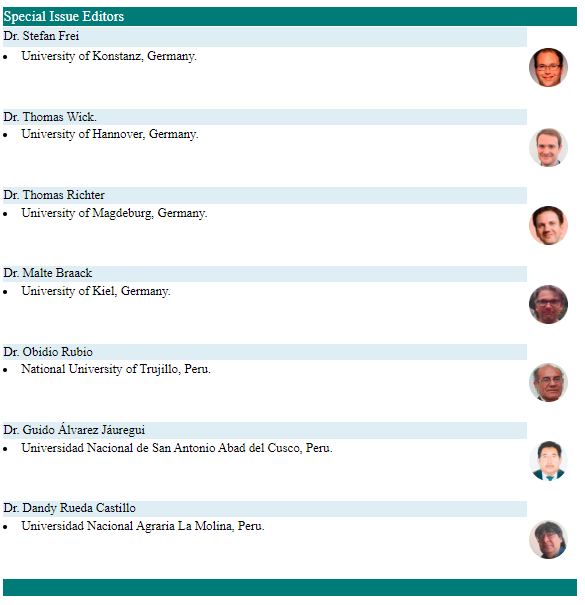Markov chains and applications
DOI:
https://doi.org/10.17268/sel.mat.2022.01.05Palavras-chave:
Markov chains, Poisson process, continuous-time Markov chain.Resumo
This work has three important purposes: first it is the study of Markov Chains, the second is to show that Markov chains have different applications and finally it is to model a process of this behaves. Throughout this work we will describe what a Markov chain is, what these processes are for and how these chains are classified. We will describe a Markov Chain, that is, analyze what are the primary elements that make up a Markov chain, among others.
Referências
Artalejo JR, Gómez-Corral A. Generalized birth and death processes with applications to queues with repeated attempts and negative arrivals. OR Spektrum. 1998; 20:5-14.
Artalejo JR, Phung-Duc T. Markovian retrial queues with two way communication. Journal of Industrial and Management Optimization. 2012; 8:781-806.
Artalejo JR, Gómez-Corral A, He QM. Markovian arrivals in stochastic modeling: A survey and some new results. Statistics and Operations Research Transactions. 2010; 34:101-144.
Caballero ME, Rivero VM. Cadenas de Markov, Un enfoque elemental. Sociedad Matemática Mexicana. 2004.
Castellanos-Rodríguez V. Forma de la Distribución cuasiestacionaria de una cadena de Markov bivariada: Aplicación a un modelo genético. M. Sc. thesis. Centro de Investigación en Matemáticas. September 2006.
Ching W, Huang X. Markov Chains: Models, Algorithms and Applications. Springer. 2013.
Devore JL. Probabilidad y estadística para ingeniería y ciencias. Seventh edition. Cengage Learning. 2008.
Durrett R. Elementary Probability for Applications. Cambrige. 2009.
Häggströng O. Finite Markov Chains and Algorithmic Applications. Cambrige University Press, 2003.
Isaac R, The pleasures of Probability. Undergraduate Texts in Mathematics. Springer. USA. 1995.
James F. Statistical Methods in Experimental Physics. Second edition. World Scientific. Singapur. 2006.
Karlin S, Mcgregor J. The classification of birth and death processes. Transactions of the American Mathematical Society. 1957; 86(2):366-400.
Kolmogorov AN, Grundbegriffe der Wahrscheinlichkeitsrechnung. Springer. 1933; Fundations of the Theory of Probability. second edition. Chelsea. 1956.
Maibaum G. Teoría de probabilidades y estadística matemática. Pueblo y educación. 1976.
Márkov AA. Rasprostranenie zakona bol’shih chiselna velichiny, zavisyaschie drug ot druga. Izvestiya Fizikomatematicheskogo obschestva pri Kazanskom universitete. 1906; 2(15):135-156.
Markov AA. Extension of the limit theorems of probability theory to a sum of variables connected in a chain. Reprinted in Appendix B of: R. Howard. Dynamic Probabilistic Systems, volume 1: Markov Chains. John Wiley and Sons, 1971.
Rabiner LR. A Tutorial on Hidden Markov Models and Selected Applications in Speech Recognition. Procedings of the IEEE. 1989; 77(2):257-286.
Rincon L. Introducción a los Procesos Estocásticos. Departamento de Matemáticas. UNAM. 2021.
Salinas Santamaría L. Procesos de nacimiento y muerte y sus aplicaciones a colas[ B. Sc. thesis]. Escuela Superior de Física y Matemáticas. Instituto Politécnico Nacional. June 2009.
Si Tung Ho L, Xu J, Crawford FW, Minin VN, Suchard MA. Birth/birth-death processes and their computable transition probabilities with biological applications. August 2017. ArXiv:1603.03819 [stat.CO].
Valenzuela M, Pruebas Estadísticas en la Física del bosón de Higgs[Tesis de Maestría], Matemáticas Aplicadas, Universidad Autónoma de Zacatecas, Mexico, february 2018. DOI: 10.13140/RG.2.2.23007.00167.
Wiener N. Differential-Space. Studies in applied mathematics, (1923); 2(4):131-174.
Wrenn-Crawford F. General birth-death processes:probabilities, inference, and applications[ Ph. D. thesis]. University of California; Los Angeles. 2012.
Downloads
Publicado
Como Citar
Edição
Seção
Licença
Copyright (c) 2022 Selecciones Matemáticas

Este trabalho está licenciado sob uma licença Creative Commons Attribution 4.0 International License.
Os autores que publicam nesta revista aceitam as seguintes condições:
Os autores mantêm os direitos autorais e atribuem à revista o direito da primeira publicação, com o trabalho registrado com a licença de atribuição Creative Commons Atribución 4.0 Internacional (CC BY 4.0), que permite que terceiros usem o material publicado sempre que mencionarem a autoria do trabalho e os direitos autorais. Primeira publicação nesta revista.
Os autores podem fazer outros acordos contratuais independentes e adicionais para a distribuição não exclusiva da versão do artigo publicada nesta revista (por exemplo, incluí-la em um repositório institucional ou publicá-la em um livro), desde que afirme claramente que o trabalho Foi publicado nesta revista.
É permitido e recomendado aos autores que publiquem seus trabalhos na Internet (por exemplo, em páginas institucionais ou pessoais) antes e durante o processo de revisão e publicação, pois isso pode levar a trocas produtivas e a uma disseminação maior e mais rápida do trabalho. publicado (Consultar: efeito do acesso aberto).












